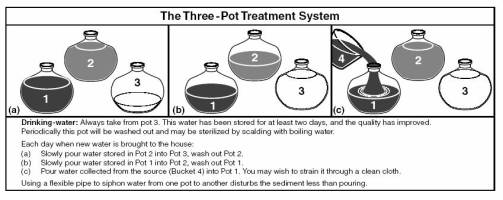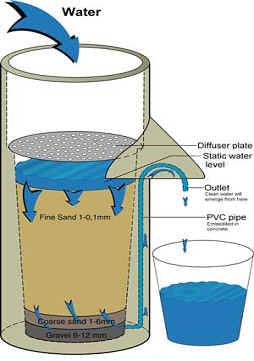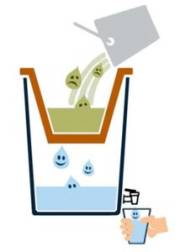Household water treatment, storage and handling
Author: Christine van Wijk, September 2005
Co-author: Trea Christoffers
Quality Assurance: Thomas Clasen
Abstract
After introducing the problems related to household water quality, this fact sheet presents an overview of options for water treatment at the point of use and ways of how safe storage and handling can be ensured. Readers will also find key documents and contacts. It overlaps partly with technical briefs prepared by Skinner and Shaw and Heber. The first brief gives figures on effectiveness, but does not address participation. The second brief covers household treatment in case of chemical contamination
Introduction
Many households still lack safe drinking water. They use unsafe drinking water because either they are not yet reached by an adequate water supply or cannot afford the connection fee or tariff. Having a water source or supply point near the home does not necessarily mean that the water is safe to drink. It may be that the water is not treated at all or is not treated well (e.g. interrupted or irregular chlorination) or that the source is not bacteriologically safe due to groundwater contamination. And even when the water is safe at the source, it may be (re) contaminated during transportation, storage and drawing at home. In all these cases safer handling of drinking water at the household level can make a great difference. (Almedon et. al. 1996; Drangert and Lundquist ,1990; Genthe and Seager, 1998; Grabow, et al, 1997). It should be cited that this fact sheet is only about dealing with water in households for bacteriological safety and not chemical safety (e.g. from arsenic or fluoride contamination).
Options for water treatment at point of use
Treating water at the point of use can result in a 35% reduction in diarr4hoeal disease, provided the water is not re-contaminated during storage and drawing (Clasen, 2005). There are various methods for such treatment:
The three pot system
This is an application of the principles that bacteriological contamination levels drop over time and through settlement. Water is poured into the first pot, if wanted through a piece of folded muslin cloth; this has the added advantage of also filtering out guinea worm cystes. The water is allowed to settle for as many hours as feasible. Storing water for just one day can result in the die-off of more than 50% of most bacteria. Longer periods of storage will lead to further reduction up to 90%. This water is then poured into a second pot and this procedure is repeated for the third pot from where the drinking water is drawn.

Figure 1: The three-pot treatment system
Source: Skinner and Shaw, 2003
As for most household water treatment and storage options, the three-pot system:
- is within control of the users, the family
- does not require complex infrastructure
- is fit for rural and peri0urban households
- is easy to use and to maintain
- is affordable
- is a good solution in terms of efficacy, cost effectiveness, returns and sustainability
Limitations:
- some bacteria and other micro-organisms might remain in the water after treatment
Boiling
This is one of the best known techniques. The water must boil for at least 10 minutes in a ‘rolling’ boil which simply means that householders can actually tell that the water has reached a sufficiently high temperature. Reaching 100°C for a few moments will kill most pathogens - most are already killed at much lower temperatures Pasteurization is effective when the water is heated to 70°C.
(Burch and Thomas, 1998).
Limitations:
- boiling water is time and energy consuming and therefore it might be difficult for poorer households to apply it. Boiling water uses up fuel. Gathering or buying firewood, charcoal or other types of fuel has an economic price.
- the boiled water takes time to cool down and needs a safe place to cool down
- the boiled water must be stored separately from unboiled water, so one needs separate containers
- there must be no risk of recontamination during storage and drawing (see next section)
- boiling affects the taste of the water, although increasing the air content by vigorously stirring the water, or shaking it in a bottle, after cooling will improve the taste.
Home chlorination or CFD (coagulation-flocculation-disinfection) sachets
Households can also buy and dissolve tablets of chlorine or a 1% solution of sodium hypochlorite, or mix their drinking water with the contents of a sachet with ferric sulphate as coagulant and calcium hypochlorite as disinfectant. The latter is superior to chlorine alone as it also reduces turbidity and organics, pesticides and heavy metals. It is very effective in visually cleaning dirty water and results in effective removal of bacteria (>99.99999%), viruses (>99.99%) and parasites (>99.9%).
Limitations:
- CFD is relatively expensive (costs are in the range of $0.01 per litre)
- dose must be correct for the amount of water used
- there has to be a reliable year round supply of chemicals near the homes
- it does not remove chemical contamination
Bio-sand/slow sand household filters
Bio-sand filtration is a simple, cheap and effective means of removing disease-causing micro-organisms from contaminated water. Slow sand filters contain very fine sand and usually function without chemical pre-treatment, such as chlorination or flocculation. The presence of harmful bacteria, parasites and other micro-organisms is greatly reduced through a ‘bio-film’. This is a biologically active layer in the top of the sand which creates an environment where most pathogens (disease-causing organisms) can not survive. The micro-organisms in the bio-film consume pathogens as they are trapped in and on the sand surface; other filtration mechanisms support the quality improvement. Slow sand filters are usually cleaned by scraping of the bio-film and/or the top sand layer. In general, slow sand filters have filtration rates of up to 0.4 m/hour.

Figure 2: The bio-sand filter
Source: http://www.biosandfilter.org/biosandfilter/index.php/item/229
A bio-sand filter:
- has an average faecal/E.coli removal rate of about 90%
- costs $10 - $50 each
- does not adequately improve the quality of chemically contaminated water
Ceramic silver impregnated filters
These filters are locally baked clay pots, where the inside is coated with colloidal silver fluid. The ceramic filtering element is made porous by mixing clay with a material burnt away during firing, such as sawdust or rice husk. The element is impregnated with colloidal silver which is a bacteriostatic ingredient that lodges on the pore walls of the ceramic material and acts like a magnet on the bacteria. The element is placed in a plastic receptacle with a faucet and covered with a lid. "Raw" water is poured into the filtering element that contains 8 litres, then seeps through the pores thereby producing potable water at a rate of 2 to 3 litres per hour. With 3 fillings per day, more than 20 litres can be produced. Cleaning is done by scrubbing the ceramic element when the pores get clogged. At the same time the receptacle should be cleaned to prevent bacterial growth.

Figure 3: The ceramic cilver impregnated filters
Characteristics of the CSF:
- a disadvantage is its vulnerability to breakage
- the cost of the coating is $0.10 per filter - the filters themselves cost $7.50 each
- ceramic filters do not treat chemical contamination
Solar disinfection
Clear plastic bottles filled with contaminated but not turbid water are exposed to full sunlight for 6 hours (clear, non-coloured glass bottles also work). The technique works through a combination of UV light and heating. In the rainy season, the bottles may need to remain exposed for two or more days. Householders must know this and adjust exposure to climatic conditions and altitude. Turbid water needs pre-treatment.
Characteristics of this method:
- cheap
- water temperature can rise above 50ºC
- very effective, faecal coliforms are reduced by 99.9% - 99.99%
- knowing whether water has had adequate exposure to sun
- not suitable in all climatic regions
Safe storage and handling
After having made the drinking water safe, it must be stored and drawn in a safe manner otherwise the water can be re-contaminated. The latter often happens when there is a communal drinking cup on top of the (covered) storage vessel. When wanting a drink, adults and children in the family dip this cup into the water and may then touch the water with soiled hands, e.g. from anal cleansing. In this way, many E-coli may be introduced into water that may originally have had very few and would have rated as sufficiently safe to drink.
There are several ways for safe water storage and drawing:
- the storage pots are covered and no more communal cups are dipped int them. All household members only draw water from the pot with a ling-handled, locally made or bought, ladle and avoid their fingers touching the water. The storage pots themselves are always cleaned well before they are refilled.
- the open storage pot is replaced by a closed system from which water is drawn by pouring or a tap at the bottom. These safer storage vessels may be anything from a narrow-necked jar to a jerry can or a pot/filter with a small tap at the bottom. SODIS bottles are also safe from contamination by touch. All these devices must however be well cleaned before refilling. This is quite hard with implements that cannot easily be scrubbed inside, such as jerry cans. In those cases, households are advised to clean by shaking with pebbles, a soap solution or a disinfectant as a solution.
Informed decision-making
A first condition for households to adopt new methods of handling and storing drinking water is that they are informed about the different options. This can be done though various types of mass media, from public media such as television, radio and the press to local media, such local posters, banners and handouts.
For informed decision-making, personal communication with PLA (Participatory Learning and Action) planning techniques in small groups is more effective. For these discussions, it is very effective to make simple black and white drawings of the various options on A4 sheets, which can easily be multiplied by photocopying. The drawings are placed into plastic pockets for protection against dirt.
The group facilitator may first explore the groups’ knowledge and views on drinking water safety. One tool for doing so is to ask the group to make a cause-and-effect drawing, writing down the cause and effects of, for example, drinking unsafe water either in words (if the group has one or more literate members) or with symbols (when they are not literate). In the latter case it is also possible to use life symbols to indicate effects, such as a stick and coin for buying firewood, or a medicine bottle for health costs.
When the group has identified and analysed the consequences of unsafe water, it can move into identifying problem solving action. To this purpose, the facilitator lays out the drawings (this is often done on the floor) and asks the group to look at them, handle them, ask questions, share information etc. In this way, information is shared about what each device is, what it can and cannot do, how much it costs etc. Having drawings of the same device made from different local materials or with different designs helps to stimulate the participants to think about variations, such as lower cost options or local design adjustments to meet local needs and practices. They then often come up with their own variations for further discussion.
Gender and social equity
When planning, testing and implementing information campaigns and informed decision making sessions, gender and poverty aspects need to be taken into account. Men and women in the different socio-economic groups may use different channels of information and have different information needs. They also usually differ in literacy levels. Older people and women are less literate than younger people and men, but it may also be the case that adolescent girls and young women are literate and young men are not, for example in fishing communities where the boys go to sea and the girls stay at home and some or all may nowadays go to school. It is thus very important to carefully segment the target audiences by sex, class and age and find the right places, times and facilitators to work with them.
The facilitators must also know how to effectively manage the process. Otherwise the less influential categories (women and girls, the poor, young people) may find themselves in a marginal position. If they can and do attend, but there is no good facilitation, they often sit at the back, cannot properly see and cannot speak, draw or otherwise participate and influence the process. Splitting up in sub-groups or having separate meetings with these groups at their own places and times is then often needed.
Gender and poverty aspects also come into the acquisition of the devices. As men and women often have different tasks and responsibilities, it will be important to discuss what the responsibility of the different types of participants (fathers, mothers, grandparents, older brothers and sisters etc.) will be with regard to divisions of work, financing, being role models etc. Taking gender and social equity aspects into account is especially important when designing strategies and in the selection and training of facilitators.
Children's education
Finally, there is the need for educating young children on safe handling of drinking water, in the home and in school. The roles of the different family members in educating the children and setting role models for them can be part of the group discussions mentioned above. In school it is possible to do participatory learning activities using materials and methods that either do not involve any material costs or can be done with materials that are already available such as slates, blackboard and chalk and implements such as buckets and glasses.
Bibliography and references
- Almedom, A., Anila Kumary, K., Francia, K.A., Mathew, K., Lalachan, P.V., Paul, L., Manoharan, B., Nagesh, C.K., Nisha, K., Remadevi, O.T., Suresh Babu, K.N and Vijayalakshmi Ammal, S. (1996). Kerala hygiene evaluation study. Trivandrum, India, Kerala Water Authroity, Socio-Economic Units.
- Burch, J and K.E. Thomas (1998) An Overview of Water Disinfection in Developing Countries and the Potential for Solar Thermal Water Pasteurization", Washington D.C., USA, US Department of Energy, National Renewable Energy Laboratory
- Clasen, Thomas (2005). Household Water Treatment. WELL Factsheet, Loughborough, UK. http://www.lboro.ac.uk/well/resources/fact-sheets/fact-sheets-htm/hwt.htm
- Drangert, J-O and Lundquist, J. (1990) 'Household water and health: issues of quality, quantity, handling and costs'. In: Nordberg, E. and Finder, D. (1990). Society, environment and health in low-income countries. Stockholm, Sweden, Karolinska Institute.
- Genthe, B. and Seager, KJ. (1996). The effect of water supply, handling and usage on water quality in relation to health indices in developing countries. (WRC report No.562/1/96). Pretoria, South Africa, Water Research Commission.
- Grabow, W.O.K., Jagais, P. and Williams, E. (1997). 'The effects of supplied water quality on human health in an urban development with limited basic subsistence facilities'. In Water SA, vol.23, no.4, p.373-378
- Heber, J. (no date). Household water treatment 2. Technical brief No.59 Loughborough, UK: WEDC. http://www.lboro.ac.uk/well/resources/technical-briefs/59-household-water-treatment-2.pdf
- Skinner, Brian and Shaw, Rod (no date). Household water treatment 1. Technical Brief No.58, Loughborough, UK: WEDC. http://www.lboro.ac.uk/well/resources/technical-briefs/58-household-water-treatment-1.pdf
- Crump, J.A., Okoth, G.O., Slusker, L., Ogaja, D.O., Keswick, B.H. and Luby, S.P. (2004). Effect of point-of-use disinfection, flocculation and combined flocculation-disinfection on drinking water quality in Western Kenya. Journal of Applied Microbiology, Vol 97, Issue 1, pp.225-231. http://www.blackwell-synergy.com/links/doi/10.1111/j.1365-2672.2004.02309.x/abs/
More information on household storage and handling options can be found on:
http://www.who.int/docstore/water_sanitation_health/healthyvil/html/ch05.htm#bm3-.3%20Household%20water%20treatment
www.sandec.nl (SODIS)
www.cawst.org (bio-sand filters)
http://www.biosandfilter.org/biosandfilter/index.php/item/229 (bio-sand filters)
http://www.healthgoods.com/Education/healthy_home_information/water_quality/bacteria_household_water.htm (on contamination and household disinfection of drinking water)
http://www.cdc.gov/safewater/manual1_toc.htm (handbook)
http://www.irc.nl/page/4480 (children's education)
Thomas F. Clasen, Joseph Brown, Simon Colin, Oscar Suntura and Sandy Cairncross, 2004. Reducing diarrhoea through the use of household-based ceramic water filters: a randomized controlled trial in rural Bolivia. American Journal of Tropical Medicine and Hygiene, 70(6), 2004, pp. 651-657
Mintz ED, Reiff FM, Tauxe RV., 1995. Safe water treatment and storage in the home. A practical new strategy ro prevent waterborne disease. Journal of the American Medical Association 273(12): 948-53.
Sobsey, Mark D., 2005. Managing water in the home: accelerated health gains from improved water supppy. Geneva, Switzerland: World Health Organization. http://www.who.int/water_sanitation_health/dwq/wsh0207/en/
Smet, Jo and Christine van Wijk, eds (2002) Small Community Water Supplies: Technology, people and partnership. Technical paper No.40. Delft, the Netherlands: IRC
http://www.ncbi.nlm.gov/entrez/query.fcgi?db=pubmed&cmd=Display&dopt=pubmed_pubmed&from_uid-7884954 (seven pages of selected articles on making drinking water safe at household level)
